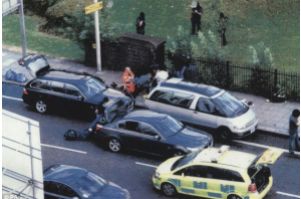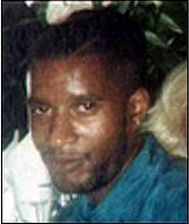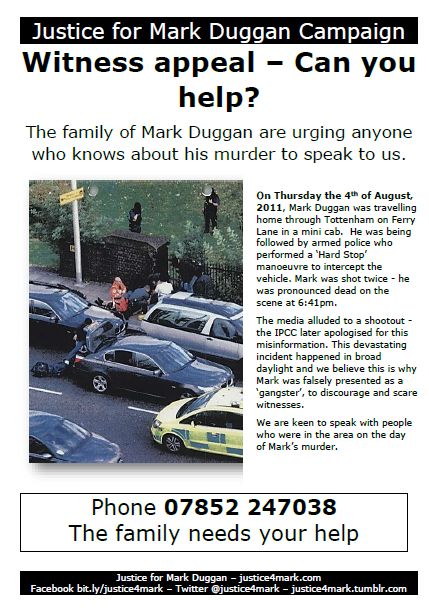Justice for Mark Duggan – An appeal for witnesses
by Phil Tsappas
The family and supporters of Mark Duggan are urging anyone who was in the Ferry Lane and Tottenham area on the day of Mark’s murder to come forward as witnesses.
 Within hours of Mark being shot dead by armed police on 4 August 2011, stories were circulating about a dramatic ‘shootout’, a ‘violent gangster’, and gangland ‘revenge killings’.
Within hours of Mark being shot dead by armed police on 4 August 2011, stories were circulating about a dramatic ‘shootout’, a ‘violent gangster’, and gangland ‘revenge killings’.
Long before the jury sat in the courtroom, the police, Independent Police Complaints Commission (IPCC), the judiciary, and the media all played important roles in determining how the shooting was framed.
Mark was shot and killed in broad daylight. The family believe this is why Mark was falsely presented as a ‘gangster’ – in order to discourage and scare witnesses from coming forward.
The family believe that witness statements can be a crucial part of bringing new evidence to light in the fight for justice for Mark. Previous cases of injustice have shown just how important witness statements have been in countering the police and media narratives of events.
On 16 December 1994 Shiji Lapite was stopped by two police officers for “acting suspiciously”. Half an hour later he was dead. The cause of death was asphyxia from compression of the neck consistent with the application of a neckhold.
Two police officers’ statements had claimed Shiji was acting suspiciously and in the officers’ notes Shiji was represented in a stereotypical and racist way, as a Nigerian drug dealer.
These police profiles were taken up by the mainstream press, who used rumours of the victim carrying drugs, to criminalise Shiji and to attempt to cut off any sympathy for him.
Shiji was presented during the inquest as “the biggest, strongest and most violent black man he’d [the police officer] had ever seen”. The Home office pathologist said Shiji was 5”10 and of medium build. The officers described him as a “ferocious animal”. A witness said he saw Shiji being continually punched and kicked – but the officers argued they fought Shiji off in self-defence. The most serious of Shiji’s injuries show crushing of his bones round his voice box.
Brain Douglas and the witness appeal
Just four months after Shiji Lapite’s death, on May 3 1995, 33-year-old Brian Douglas was on his way home when he was stopped by two police officers, PC Tuffy and PC Harrison. Brian was with his friend Stafford. The officers ordered them out of the car and, apparently unprovoked, hit Brian on the head with a new US-style baton. Brian had a fractured skill and was falling in and out consciousness, yet the police kept him for 15 hours before taking him to hospital. He was declared dead on 8 May.
 In the police’s internal investigation, PC Tuffy claimed he hit Douglas on the shoulder and that the baton slid up to strike him on the head. The Douglas family began a door to door witness appeal. Brenda Weinberg, Brian’s sister, says that “There were several witnesses which actually saw the blow to Brian”. According to one witness, the officer “turned and made an over arm blow”. So there’s nothing that could have slid up! The blow came from an over arm movement – the strongest force you can use. To the family, that was not an accident, or even a defensive move, it was an attack blow.
In the police’s internal investigation, PC Tuffy claimed he hit Douglas on the shoulder and that the baton slid up to strike him on the head. The Douglas family began a door to door witness appeal. Brenda Weinberg, Brian’s sister, says that “There were several witnesses which actually saw the blow to Brian”. According to one witness, the officer “turned and made an over arm blow”. So there’s nothing that could have slid up! The blow came from an over arm movement – the strongest force you can use. To the family, that was not an accident, or even a defensive move, it was an attack blow.
The strength of the witness appeal in the Mark Duggan case
The IPCC attempted to gather witness statements when they were gathering evidence to be used at the inquest into the murder of Mark. It was noted that CCTV footage was gathered from “a number of sources” and then synced. But where was this footage gathered from and was all the evidence available used in court?
The IPCC was allowed to see intelligence relating to the planning of the Met police operation. However, when the IPCC commissioned a local superintendent to prepare a report on this, the evidence was prevented from being released, effectively denying the IPCC any access to police intelligence concerning the operation.
Legislation passed over the last 15 years has progressively increased the use of secret evidence, which has significantly undermined the accountability of policing operations. Most of the ‘information’ concerning Mark’s actions came from the armed officers who gave evidence at the Kevin Hutchinson-Foster trial, which was splashed round the right wing press – including the unproven allegation that Mark was holding a gun. The following is taken from the institute of Race Relations – Framing the Death of Mark Duggan. The quote from Shaun Hall, Mark’s brother, near the end of the excerpt is very powerful:
CO19, armed officers, supported the operation (‘mobile armed support to surveillance’) gave their account at this trial. This is where the claim that Mark had been holding a gun began to emerge, unchallenged. Months before the inquest.
By the time of the inquest, in September 2013, it was the IPCC who had gathered ‘most’ of the evidence, while public opinion had been guided considerably by the Kevin Hutchinson-Foster trial. The mainstream press used this trial to present the police profiles as the main source of accurate information.
Witness C, a BBC journalist, was asked about witness B (a citizen who filmed up to 8 minutes of footage after Mark was shot):
A. He said he had no trust towards the police. He talked about events, and there are some notes that I’ve made, you know previously, but he talked about that he had no trust towards the police and that he would not go to the police.
A. He would not go. He would not go to — he did not want to go to the police and he did not want to go to the IPCC and I sensed that he was very scared.
Q. Could you work out who he was scared of?
A. He was scared of the police. “So things like that played on my mind for a bit, as well, and you have people also talking, a whole bunch of stuff as well. So — yeah.
Question: “What sort of things?
Answer: “About, erm, him being in Tottenham, you know, all this stuff coming out like, you know — you know, gangs and all of that stuff really, so I just didn’t want to be bothered with it, that was it.”
The coroner wrote in his recent report:
“I had the assistance of a team. It commissioned further expert reports and with its assistance I decided which witnesses to call. Among those witnesses was a man who came to be known as Witness B. At the time of the shooting he lived in a flat overlooking Ferry Lane. He was alerted to the shooting and he captured some of its aftermath using the camera on his mobile phone and a camera. He provided the footage to the BBC and, with the benefit of my powers of compulsion, Witness B was persuaded to give evidence to explain what he had seen and heard… His evidence was plainly significant. Despite the IPCC’s call for witnesses and notwithstanding a similar exercise undertaken on my behalf, I very strongly suspect there were other eyewitnesses to the shooting, but none came forward.”
Mark’s family and supporters of the Justice for Mark Duggan campaign want to conduct a thorough witness appeal and to bring new evidence to light. If you or anyone you know was in the area on the day at the time of, or before and after the time when Mark was murdered, Mark’s family would like to talk to you, even if what you saw doesn’t seem to be crucial.
Please get in touch by phoning 07852 247038
Links for info:
Police baton blow blamed for man’s death





Join the discussion